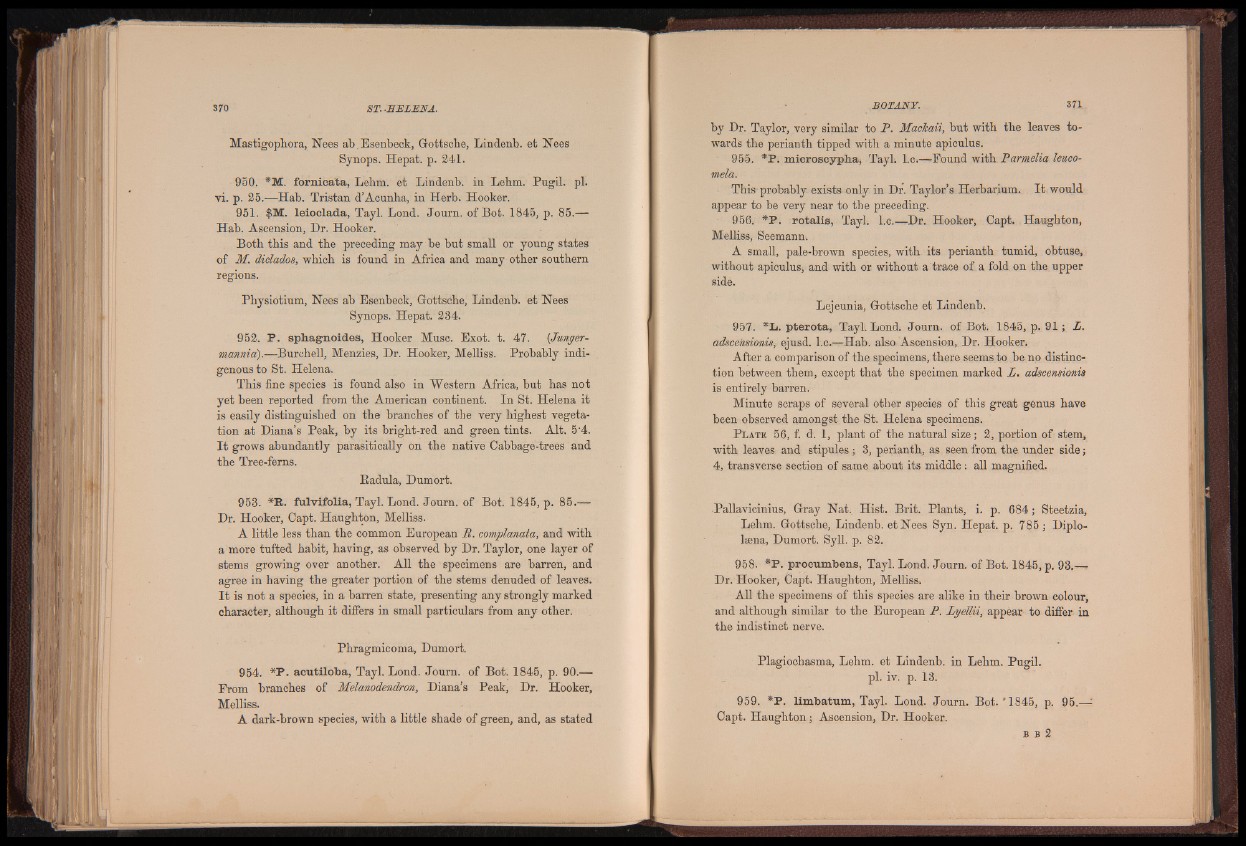
Mastigophora, Nees ab.Esenbeck, Gottsche, Lindenb. et Nees
Synops. Hepat. p. 241.
950. *M. fornica'ta, Lehm. et Lindenb. in Lebm. Pugil. pi.
vi. p. 25.—Hab. Tristan d’Acunha, in Herb. Hooker.
951. $M. leioclada, Tayl. Lond. Journ. of Bot. 1845, p. 85.—
Hab. Ascension, Dr. Hooker.
Both this and the preceding may be but small or young states
of M. diclados, which is found in Africa and many other southern
regions.
Physiotium, Nees ab Esenbeck, Gottsche, Lindenb. et Nees
Synops. Hepat. 234.
952. P. sphagnoides, Hooker Muse. Exot. t. 47. {Junger-
mannia).—Burchell, Menzies, Dr. Hooker, Melliss. Probably indigenous
to St. Helena.
This fine species is found also in Western Africa, but has not
yet been reported from the American continent. In St. Helena it
is easily distinguished on the branches of the very highest vegetation
at Diana’s Peak, by its bright-red and green tints. Alt. 5'4.
I t grows abundantly parasitically on the native Cabbage-trees and
the Tree-ferns.
Radula, Dumort.
958. *R. fulvifolia, Tayl. Lond. Journ. of Bot. 1845, p. 85.—
Dr. Hooker, Capt. Haughton, Melliss.
A little less than the common European B. complanata, and with
a more tufted habit, having, as observed by Dr. Taylor, one layer of
stems growing over another. All the specimens are barren, and
agree in having the greater portion of the stems denuded of leaves.
I t is not a species, in a barren state, presenting any strongly marked
character, although it diifers in small particulars from any other.
Phragmicoma, Dumort.
954. *P. acutiloba, Tayl. Lond. Journ. of Bot. 1845, p. 90.—
Prom branches of Melanodendron, Diana’s Peak, Dr. Hooker,
Melliss.
A dark-brown species, with a little shade of green, and, as stated
by Dr. Taylor, very similar to P. MacJcaii, but with the leaves towards
the perianth tipped with a minute apiculus.
9 5 5 . *P. microscypha, Tayl. 1.0.—Pound with Parmelia leuco-
mela.T
his probably exists only in Dr. Taylor’s Herbarium. I t would
appear to be very near to the preceding.
9 5 6 . *P. rotalis, Tayl. I.e.—Dr. Hooker, Capt. Haughton,
Melliss, Seemann.
A small, pale-brown species, with its perianth tumid, obtuse,
without apiculus, and with or without a trace of a fold on the upper
side.
Lejeunia, Gottsche et Lindenb.
9 5 7 . *L. pterota, Tayl. Lond. Journ. of Bot. 1 8 4 5 , p, 9 1 ; L.
adscehsionis, ejusd. I.e.—Hab. also Ascension, Dr. Hooker.
After a comparison of the specimens, there seems to be no distinction
between them, except that the specimen marked L. adscensionis
is entirely barren.
Minute scraps of several other species of this great genus have
been observed amongst the St. Helena specimens.
P l a t e 5 6 , f. d . 1 , p l a n t o f t h e n a t u r a l s i z e ; 2 , p o r t i o n o f s t em ,
w i t h le a v e s a n d s t i p u l e s ; 3 , p e r i a n t h , a s s e e n f r o m t h e u n d e r s i d e ;
4 , t r a n s v e r s e s e c t io n o f s am e a b o u t i t s m i d d l e : a l l m a g n i f ie d .
Pallavicinius, Gray Nat. Hist. Brit. Plants, i. p. 6 8 4 ; Steetzia,
Lehm. Gottsche, Lindenb. etNees Syn. Hepat. p. 7 8 5 ; Diplolsena,
Dumort. Syll. p. 8 2 .
9 5 8 . *P. procumbens, Tayl. Lond. Journ. of Bot. 1 8 4 5 , p. 9 3 .— .
Dr. Hooker, Capt. Haughton, Melliss.
All the specimens of this species are alike in their brown colour,
and although similar to the European P. Lyellii, appear to differ in
the indistinct nerve.
Plagiochasma, Lehm. et Lindenb. in Lehm. Pugil.
pi. iv. p. 1 3 .
9 5 9 . *P. limbatum, Tayl. Lond. Journ. Bot. * 1 8 4 5 , p. 9 5 .— ;
Capt. Haughton; Ascension, Dr. Hooker.